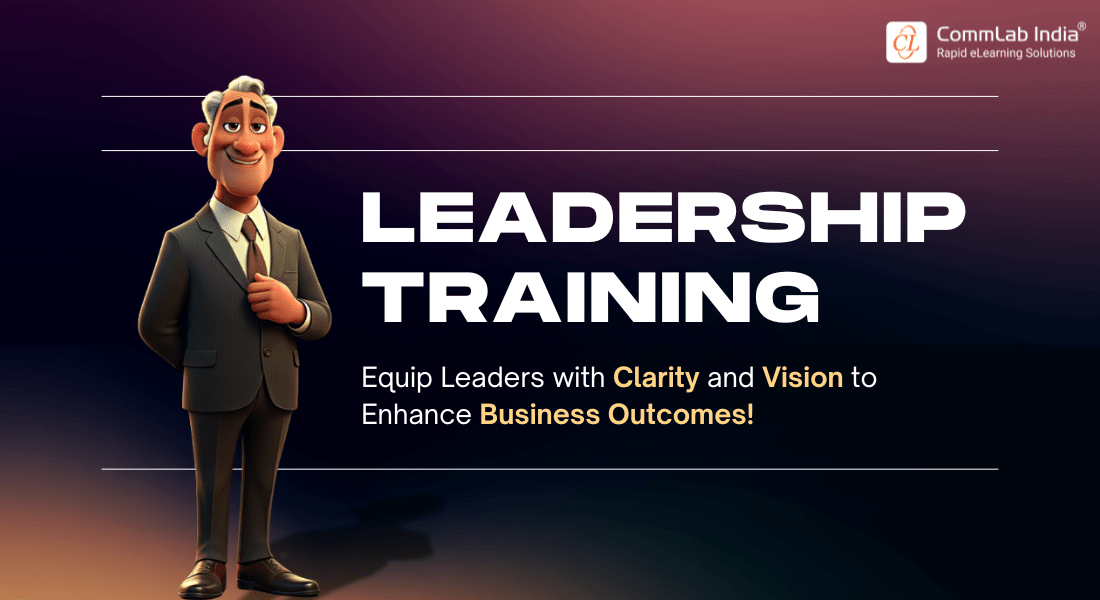How Leadership Training Creates Impactful Leaders Everyone Respects

In today’s corporate world, effective leadership is crucial for driving success and fostering a positive work environment. Among the many styles nurtured in corporate and business leadership training, respectful leadership stands out as a powerful approach that promotes trust, collaboration, and employee engagement. By embracing respectful leadership, organizations can build strong, cohesive teams that thrive in today’s competitive business landscape.
→ Download Now: How L&D And Business Can Align to Conquer The Future Of Work
Table Of Content
- Why Respectful Leadership Matters?
- What are the Benefits of Leadership Training?
- What are the Leadership Training Topics to Include in an L&D Strategy?
Why Respectful Leadership Matters?
Respectful Leadership: A Style that Inspires and Empowers
Here’s what sets the respectful leaders apart:
- They set the tone for employee behavior
- Are more effective
- Get more support
- Have more influence
- Have better relationships
- Offer constructive feedback that can help increase motivation
Respectful leadership definitely stands out among various other leadership styles. Here are some hard-to-ignore perks of that come by practicing respectful leadership:
1. Respectful Leaders Set the Tone for Employee Behaviour
A leader’s positive behaviour sets the tone for employees’ conduct. When a boss or manager is courteous, it’s more likely that others will show courtesy as well. If you want to see how this works in real life, just think about how much influence your parents have over you when they’re being kind and encouraging versus when they’re angry and overly critical.
The same applies to leaders: A considerate environment helps foster a space where employees feel secure enough to share their ideas with one another and also gives them the freedom and confidence to disagree politely. The disagreement can be in terms of opinions, actions, or decisions.
2. Respectful Leaders are More Effective
Respectful leaders are more likely to get support from their team, which makes them more effective at leading. Employees who feel respected by their boss are more likely to go above and beyond for that person, so the leader can ask them for help without any hesitation. In fact, with the trust and respect in place, even the employees don’t have to worry about being taken advantage of or having their time wasted.
Let me explain! When an employee feels valued by their manager, they are also more likely to trust them, fostering a strong bond between manager and employee. This trust leads directly to buy-in: when employees feel as though they have been treated with consideration by their leaders, they are more willing to accept decisions made by those leaders without question or complaint (because the employees believe that those decisions have been made thoughtfully), thereby enhancing credibility and effectiveness.
3. Respectful Leaders Get More Support
When you treat employees with respect, they’re more likely to help you and each other, improving teamwork and making it easier to reach goals. Regular appreciation and acknowledgment help employees feel proud of their work and aligned with company goals, boosting productivity and profitability.
Respectful leaders also create a positive work environment and support employee growth through training. They listen to and value their team’s opinions, empowering employees and building their loyalty and support.
4. Respectful Leaders Have More Influence
Being a considerate leader makes you more influential. That’s right! You may think that the best leaders are those who give orders and expect people to follow them, but this isn’t always the case. In fact, leaders who treat others with courtesy are more likely to gain support, cooperation, help, and loyalty from those they lead compared to those who show no regard for others. They also have a better chance of getting buy-in for their ideas and projects.
Thoughtful leaders inspire, motivate, and guide others because they’re not just saying “Do it” all the time. Instead, they’re asking you to do something and explaining why it’s important to accomplish the task. This makes people feel appreciated by the organization and their leader. Trust me, if someone values my work enough to explain why it matters, I’ll feel more motivated than ever, with a deep respect for the person guiding me.

How L&D And Business Can Align to Conquer The Future Of Work
Bridging the Gap Between Organizational and Individual Goals!
- Learning Strategies Shaping the Future
- Changing Role of Learning Professionals
- Learning to Solve Business Challenges
- And More!
5. Respectful Leaders Have Better Relationships
Respectful leaders have a better chance of maintaining good relationships. Be it their employees, team members, customers, or vendors. But how? Well, the best way to ensure cordial relationships is by building trust with your team. Trust definitely fosters from being respectful, even when things get tough and aren’t going as per your plan.
By showing respect for others’ ideas and contributions, you’ll earn their trust in return–and make it easier for them to want to work hard for you. They will relate to your success as their own and take accountability as a team if things go south instead of pointing fingers at each other or blaming you. Your employees make the best of their effort to understand your perspective if you treat them with respect and dignity.
6. Respectful Leaders Offer Constructive Feedback that Can Help Increase Motivation
One key to employee motivation is regular, constructive feedback. It helps employees improve performance, build confidence, and stay motivated, benefiting both them and the company.
Feedback is vital for growth, but how it's delivered matters. Good leaders provide feedback in a positive way, making employees more open to suggestions and eager to improve. Instead of criticizing mistakes, frame feedback as a learning opportunity and focus on areas for growth.
We’ve seen how respectful leadership, in particular, can foster trust and collaboration within teams. Want to improve leadership training? Start by understanding different leadership styles and how they impact team growth.
What are the Benefits of Leadership Training?
Effective leadership sets the foundation for a positive and productive workplace, but sustaining such leadership requires the right skills and mindset. This is where corporate leadership development training comes in. It ensures that effective leadership isn’t just a concept but a daily practice.
Let’s explore how leadership training can elevate an individual’s ability to lead with impact and integrity.
1. Increases Productivity
Effective leaders are capable of inspiring and motivating their teams like no other! And leadership skills training equips employees with skills that help them become effective leaders. Imparting skills such as effective communication, problem-solving, decision-making, etc., enable leaders to delegate tasks effectively, provide clear instructions, and ensure accountability among their team members. All these factors contribute to higher levels of productivity, improved performance, and better alignment with goals.
2. Improves Employee Engagement and Reduces Turnover
For any successful organization, employee engagement and retention are the backbone. To hold true to this idea, leaders play a vital role. Leadership development training enables leaders to cater to the well-being and interests of their team to ensure efficiency and job satisfaction.
Pro Tip:
Enhance your corporate and business leadership training with custom eLearning solutions tailored to your organization's unique needs.
Through leadership training programs, they learn strategies to lead effectively, empower their team members, recognize their contributions, and create a positive work culture that ensures engagement at work. This fosters loyalty and commitment among employees, leading to reduced turnover rates.
3. Supports Innovation and Adaptability
Leadership skills training encourages leaders to think strategically and embrace innovation. When leaders are equipped with skills such as creative thinking, problem-solving, and adaptability, they (as well as their teams) can navigate challenges with confidence. This drives organizational growth and resilience in rapidly evolving markets.
4. Promotes Conflict Resolution and Collaboration
Leaders capable of ensuring satisfactory conflict resolution tend to foster harmony and collaboration among team members. To help leaders develop or polish these skills, you can leverage different training formats to deliver corporate leadership training programs that go a long way. They provide leaders with techniques to manage conflicts constructively, thereby minimizing disruptions and promoting cohesive teamwork.
5. Enables Succession Planning and Talent Development
When it comes to succession planning and talent development within organizations, leadership development program is the key. By nurturing leadership skills among employees at all levels, companies ensure a pipeline of capable leaders that are ready to assume key roles, facilitating continuity and long-term success.

How L&D And Business Can Align to Conquer The Future Of Work
Bridging the Gap Between Organizational and Individual Goals!
- Learning Strategies Shaping the Future
- Changing Role of Learning Professionals
- Learning to Solve Business Challenges
- And More!
What are the Leadership Training Topics to Include in an L&D Strategy?
Strong leadership is the backbone of any successful organization, yet many companies struggle to develop effective leaders. In fact, according ATD a staggering 75% of organizations admit their leadership development programs fall short of expectations. This highlights a critical gap in learning and development strategies—one that can directly impact team performance, employee engagement, and overall business growth.
So, what can organizations do to bridge this gap? It starts with focusing on the right leadership training topics.
Topic 1: Communication Skills
Effective communication is essential for strong leadership. It helps leaders share their vision, build trust, and resolve conflicts with clarity. Poor communication makes it hard to influence teams, align expectations, and create shared purpose.

Topic 2: Emotional Intelligence
Emotional intelligence (EQ) is the ability to manage one’s emotions and understand others’. Leaders with high EQ foster positive team environments, build strong relationships, and make better decisions under pressure.
Only 29% of employees say their skip-level leader is effective at human leadership, which includes authenticity, empathy, and adaptivity.
Source: Gartner
Key areas of EQ that can be included in leadership development program:
- Self-awareness: Recognizing your emotions and how they affect your behavior. Leaders should understand their triggers, strengths, and weaknesses.
- Emotional Regulation: Managing emotions productively, especially under stress. Mindfulness and breathing techniques can help leaders stay calm.
- Empathy: Understanding others' perspectives makes team members feel valued. This creates a supportive and cohesive workplace.
Topic 3: Conflict Resolution
Conflict is inevitable at work. Poorly managed conflict can harm morale, productivity, and retention. Leaders must address it effectively and create paths to resolution. Leadership training programs should focus on:
- Identifying Root Causes: Looking beyond surface disagreements to uncover the core issues.
- Mediation Techniques: Facilitating productive discussions, finding common ground, and negotiating solutions.
- Fostering Healthy Disagreement: Creating a culture where differing opinions are shared respectfully, leading to better decisions, learning, and innovation.
Topic 4: Strategic Thinking and Decision-Making
Strong leaders must handle daily challenges while thinking strategically. This means seeing the "big picture," aligning their team's work with organizational goals, and making decisions with long-term impacts in mind.
Training should focus on:
- Data-driven Decision-making: Leaders should use data to guide choices, reducing bias and ensuring decisions are fact-based. Learn more about predictive and prescriptive analytics in this short video.
- Understanding Long-term Impacts: Leaders need to consider how decisions affect their team, customers, and business over time.
- Balancing Risk vs. Reward: Progress requires calculated risks. Leaders should weigh risks against potential rewards to make informed choices.
Topic 5: Delegation and Empowerment
Great leaders don’t do everything themselves. They trust and empower their teams. Delegation isn’t just offloading tasks—it’s about fostering growth.
Training should focus on:
- Overcoming the Urge to Micromanage: Leaders must learn to trust their team with meaningful tasks.
- Choosing the Right Tasks to Delegate: Leaders should align tasks with their team members' skills and development goals.
- Providing Support and Feedback: Delegation requires leaders to guide, monitor, and offer feedback to help their team succeed.
Topic 6: Mentorship and Coaching
Mentorship and coaching are vital tools for developing leadership skills at all levels of an organization. Mentorship involves building long-term relationships where experienced individuals provide guidance, share their knowledge, and offer valuable insights to help mentees navigate their professional growth. Coaching, on the other hand, is more focused and goal-oriented, aiming to develop specific skills or improve performance through structured feedback and personalized strategies. Together, mentorship and coaching empower individuals to grow, adapt, and excel in their roles, fostering stronger leaders and more resilient teams.

Wrapping up!
As workplaces continue to evolve with new technologies and diverse teams, leadership training remains a cornerstone for creating leaders who inspire respect and drive innovation. Investing in leadership development today ensures tomorrow’s leaders can adapt, connect, and lead with purpose in an ever-changing world.
Ready to crack the success code and conquer the future of work? Download our free eBook to discover how to solve business challenges while bridging the gap between organizational and individual goals. Start building tomorrow’s leaders today!






